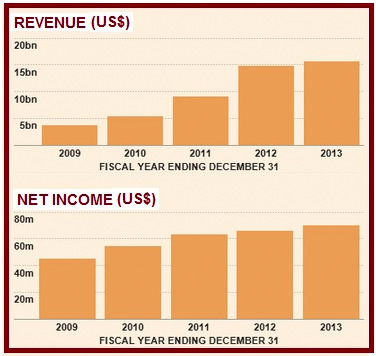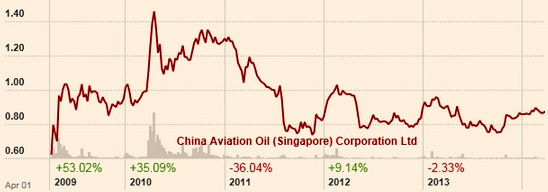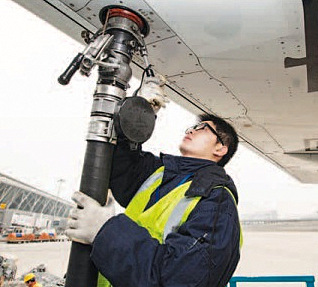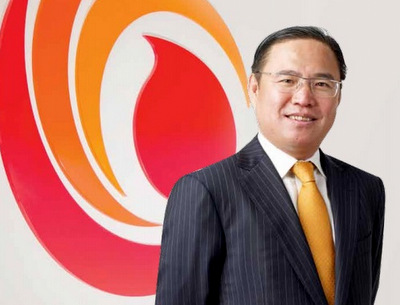 5 consecutive years of record profit. Source: FT.ComCHINA AVIATION OIL, which holds the monopoly for importing jet fuel into China, not only flew to record profit levels last year but made it its fifth consecutive year of achieving record profits.
5 consecutive years of record profit. Source: FT.ComCHINA AVIATION OIL, which holds the monopoly for importing jet fuel into China, not only flew to record profit levels last year but made it its fifth consecutive year of achieving record profits.Net profit attributable to shareholders increased 6.1% year-on-year to US$70.2 million while group revenue also hit another record high of US$15.6 billion.
Oddly, the market has not rewarded the company with a record-breaking stock price (see chart below).
In fact, the stock is currently trading at 87.5 cents, a level which is far below its peak in 2010.
The PE is 8.4X on last year's earnings, which does not appear to be expensive at all for a company that not only has achieved rising profitability but has a S$750-million market cap -- sizeable enough to attract fund-buying.
CAO proposed a first and final dividend for FY2013 of 2 SG cents a share, or a 2.3% yield on the current stock price. The dividend is unchanged from the year before but it's payable also on the bonus shares (1 bonus share for 5 CAO shares) issued recently.
A recent dampener on investor sentiment could be its 4Q2013 result: Net profit fell 25.7% to US$13.5 million, largely due to a 39% fall in contribution from associates.
For more on the results, see CAO's Powerpoint materials which have been uploaded to the SGX website.
 Largest shareholder of CAO is state-owned enterprise China National Aviation Fuel Group Corp, which holds a 51% stake. BP is No.2 with 20%. Chart: FT.com
Largest shareholder of CAO is state-owned enterprise China National Aviation Fuel Group Corp, which holds a 51% stake. BP is No.2 with 20%. Chart: FT.com 3 Key Challenges  CAO supplies jet fuel to key international airports in China. Photo: CompanyA peek into the just-released 2013 annual report yields insights into its strategy for the future -- in a word, CAO is looking global -- as well as key challenges it faces. CAO supplies jet fuel to key international airports in China. Photo: CompanyA peek into the just-released 2013 annual report yields insights into its strategy for the future -- in a word, CAO is looking global -- as well as key challenges it faces.CEO Meng Fanqiu identified three key challenges: a. Exacerbated by speculative activities, oil prices will remain volatile at higher prices. This "may pose greater challenges in terms of trading risk exposure." b. China’s economic growth is slowing down and China's domestic refining capacity is increasing -- both factors will contribute to a slowing down of demand for jet fuel imports into China. c. Growth in demand for jet fuel is also slowing down in the Asia-Pacific. "CAO needs to, and will, enhance its capabilities for globalized operations. Its asset network will be improved to support business expansion and we will establish our business value chain through greater synergy and optimisation," said Mr Meng. "We would also need to improve the trading of other oil products by establishing and consolidating our structural advantages." |
|
Supply and trading of jet fuel Business volume increased 34.4% year-on-year in 2013, and CAO envisages much more room to grow.  Meng Fanqiu,45, has been CEO of China Aviation Oil since May 2008. Photo: annual report"Our presence in Asia Pacific, Europe and North America today forms the rudiment of CAO’s global network which will be developed further to create and strengthen synergies," said Mr Meng. Meng Fanqiu,45, has been CEO of China Aviation Oil since May 2008. Photo: annual report"Our presence in Asia Pacific, Europe and North America today forms the rudiment of CAO’s global network which will be developed further to create and strengthen synergies," said Mr Meng. Trading of other oil products
Leveraging on its structural advantages, CAO intends to step up its gas oil business volume by developing new markets for physical trades.
For its fuel oil business, CAO will continue to leverage on its Singapore storage facilities to operate fuel oil bulk cargo sub-packaging and blending. CAO’s petrochemical business will leverage on its footprint in the PRC market and diversify to other oil products to enlarge its customer base, and increase term contract volumes. Aviation Marketing CAO seeks to supply jet fuel to more airlines in more airports around the world. For that, it will continue to create strategic alliances with both suppliers and airline companies. Strategic Asset Investments
CAO will extend its logistics supply chain through mergers and acquisitions to facilitate its entry into new markets and inorganic growth.
It will seek projects with reasonable returns which are complementary to its business operations including storage facilities, pipelines, jetties and refueling facilities at airports. In addition, CAO seeks to acquire trading companies with established sales networks as well as suppliers with a captive customer base. Spreading its wings
New markets are vital to CAO's strategy for growth. It has done studies on new markets such as Australia and the Middle East to enhance its global business network. And it is exploring new products such as aviation biofuels and LNG. |






